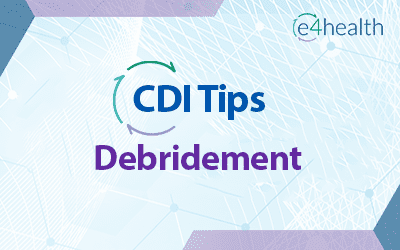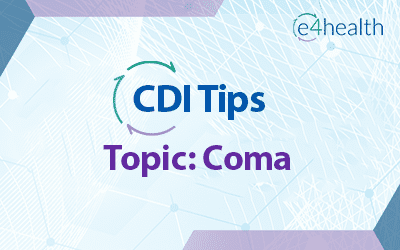Dural Tear Clarification Per Coding Clinic, First Quarter 2024: A dural tear is clinically significant and should always be reported when documented by the provider. G97.41, accidental puncture or laceration of dura during a procedure is a CC...
The latest information to keep updated for advanced coding.
CDI Tips & Friendly Reminders: Atrial Fibrillation (AF)
May 16, 2024 | CDI, Coding + CDI, Coding Tips, Education & Training, News
Atrial Fibrillation (AF) Paroxysmal AF Definition: Episodes terminate either spontaneously or with treatment within 7 days; may recur Persistent AF Definition: AF is continuous and lasts > 7 days, fails to terminate spontaneously Long-standing Persistent AF...
Coding Corner Tips: Myocardial Infarction with Angina
May 14, 2024 | Coding, Coding Tips, Education & Training, News
Myocardial Infarction with Angina Per Coding Clinic, First Quarter 2024: Is it appropriate to assign a code for CAD with angina for the severe native multi-vessel disease that resulted in the MI? Examples: Assign code I21.4: Non-ST elevation (NSTEMI) myocardial...
Coding Corner Tips: Underdosing
May 9, 2024 | Coding, Coding Tips, Education & Training, News
UnderdosingPer Coding Clinic, First Quarter 2024: Underdosing when a PRN medication is not taken Example: Documentation states: A patient presents to the ED with shortness of breath due to an exacerbation of asthma. The patient did not take his PRN medication,...
CDI Tips & Friendly Reminders: Debridement
Apr 18, 2024 | CDI, Coding + CDI, Coding Tips, Education & Training, News
Debridement Excisional Debridement Definition: The surgical removal or cutting away of devitalized tissue, necrosis, and slough. Non-Excisional Debridement Definition: The nonoperative brushing, irrigating, scrubbing, or washing of devitalized tissue, necrosis,...
CDI Tips & Friendly Reminders: Coma
Mar 15, 2024 | CDI, Coding + CDI, Coding Tips, Education & Training, News
ComaDefinition: Deep state of unconsciousness where patients are unable to move or be aware of or respond to their surroundings with loss of thinking abilities however retain non-cognitive function and normal sleep patterns.Diagnostic CriteriaA comprehensive...
Coding Tips: New Codes for Sickle Cell Disease with Dactylitis
Mar 6, 2024 | Coding, Coding Tips, Education & Training, News
New Codes for Sickle Cell Disease with Dactylitis (Valid for October 1, 2023 discharges)• D57.04 Hb-SS disease with dactylitis• D57.214 Sickle-cell/Hb-C disease with dactylitis• D57.414 Sickle-cell thalassemia, unspecified, with dactylitis• D57.434 Sickle-cell...
Coding Tips: Complication Comorbidity Update
Feb 19, 2024 | Coding, Coding + CDI, Coding Tips, Education & Training, News
Complication Comorbidity UpdateSocial Determinants of Health (SDOH) codes Z59.00, Homelessness unspecified, Z59.01, Sheltered homelessness and Z59.02, Unsheltered homelessness will be considered CC’s (complication/comorbidity) beginning with October 1, 2023...
CDI Tips & Friendly Reminders: Pathological Fractures
Feb 15, 2024 | CDI, Coding + CDI, Coding Tips, Education & Training, News
Pathological FracturesDefinition: A bone fracture that occurs without adequate trauma, caused by an underlying disease.Diagnostic CriteriaIdentified in Radiology/Diagnostic Imaging such as X-Ray, CT, MRI, or bone scans. There are various underlying causes for...
Coding Tips: New Code for Resistant Hypertension
Feb 7, 2024 | Coding, Coding Tips, Education & Training, News
New Code for Resistant Hypertension (Valid for October 1, 2023 discharges)I1A.0 Resistant hypertension May be documented as: Apparent treatment resistant hypertension, Treatment resistant hypertension, True resistant hypertension. The ICD-10-CM Tabular instruction...
CDI Tips & Friendly Reminders: Hypertensive Crisis
Jan 22, 2024 | CDI, Coding + CDI, Coding Tips, Education & Training, News
Hypertensive CrisisDefinition: HTN: Systolic blood pressure (SBP) of 130mm Hg or more and/or diastolic blood pressure (DBP) of more than 80mm Hg HTN Crisis: Generic term to describe hypertensive urgency or hypertensive emergency, typically seen with elevated blood...
Decoding V28 Transition: Key Takeaways from Journal of AHIMA
Dec 21, 2023 | CDI, Coding, Coding + CDI, Coding Tips, Education & Training, Industry Insights, News
Medicare Advantage is on the brink of a significant restructuring as it transitions from V24 to V28 of the hierarchical condition categories (HCCs) risk adjustment model. In a recent Journal of AHIMA article, I partnered with Jeanie Heck, BBA, CCS, Education...







